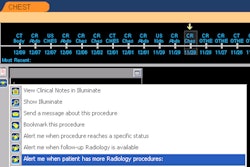All physicians must be licensed in any state in which they practice, a requirement that can be time-consuming and costly for those wanting to practice telemedicine and teleradiology. But a bill expected to be introduced in Congress this year aims to make it easier to use medical licenses across state lines.
In addition to creating a comprehensive and interoperable database of verified physician credentials, the legislation being developed by U.S. Sen. Tom Udall (D-NM) calls for the creation of a tandem state/national license that would allow physicians to provide telehealth services in states accepting the tandem license, according to Fern Goodhart, Udall's legislative assistant.
"We're exploring how to build in streamlined or automatic license portability across state lines," she said.
Goodhart discussed the planned bill during a briefing on state medical licensure reform on January 31 in Washington, DC, sponsored by the American Telemedicine Association (ATA).
A vital tool
While state medical licensure is a vital tool for patient protection, fees for medical license applications vary across states, from a low $110 to more than $1,300, Goodhart said. "And the time to obtain these licenses varies from three to 12 months, although the actual state requirements for these licenses varies little, if at all," she said.
Unless physicians work within the Department of Veterans Affairs (VA) or the Indian Health Service (IHS), there is no current state reciprocity for licenses; each state requires its own license to practice medicine within its borders, Goodhart said.
Udall began working on the bill to address concerns over whether the duplication of health licensing and credentialing delayed patient care, slowed the hiring of healthcare workers, and increased costs and administrative burdens.
The legislation has several parts. First, the bill would expand license portability within all federal agencies that provide healthcare and for licensed first responders in case of an emergency.
"For example, a physician could transfer from the VA to the IHS without getting recredentialed," she said. "[Also,] a physician could respond to an emergency without having first registered with the surgeon general or responding nongovernmental organization since they already would be in this database."
The bill would also streamline credentialing by developing a unified set of standardized data via a comprehensive, interoperable data system of primary, source-verified credentials, Goodhart said. Claims history, hospital privileges, and criminal background information would be included with a unified application.
"All of the information is collected once, and it's stored in an interoperable database," she said, "It wouldn't have to be one database, as long as the databases could talk to each other."
For example, physician credentials could be more easily reviewed by employers, health plans, and hospitals without resupplying the same information, she said. License renewals would also be on the same date and cycle, instead of having state licenses that renew at different times.
"Think of it as a national practitioner database or unified provider database or federation credentials verification source on steroids, with improvements," she said.
State, national options
Five state options could provide license portability, Goodhart said. Consulting exceptions would allow a physician who is unlicensed in one state to practice medicine in that state if consulting on a case for a licensed physician.
A reciprocity approach would involve states entering into agreements to recognize certain medical privileges on the condition that the other states' physicians enjoy the same privileges in the state, she said. A mutual recognition policy would allow a licensing authority to voluntarily accept the home state licensure of the applicant.
With registration, physicians could register to practice in that state and agree to operate under the legal authority and jurisdiction of that state, she said. In addition, an expedited endorsement could occur, enabling states to accept the license of an out-of-state physician provided certain conditions are met.
The bill's authors have also identified two potential nationwide options to provide license portability. A national licensure approach would issue licenses based on a universal, national standard, while a federal licensure model would issue licenses by the federal government, Goodhart said.
Tandem license
Legislative language in the current draft bill calls for a voluntary tandem license: one state license with a national license. This would enable a licensed healthcare professional to provide telehealth services with a tandem license in any state recognizing that license, Goodhart said.
Incentives would be provided for states to accept tandem licenses, she said. States would maintain authority for investigation and discipline; all physicians practicing in their states would be registered, allowing access to real-time information regarding any problems with physicians.
"So we see this would allow less delay, less redundancy, less cost, more patient care, and greater data sharing," she said.
The bill also calls for a national task force for communication, coordination, and collaboration, as well as to cover e-health needs, standards, federal goals, and efforts, Goodhart said.
The American College of Radiology (ACR) declined to comment on the planned legislation until it's formally introduced in Congress.
The wrong target?
While there is obvious appeal to knocking down barriers to telemedicine and teleradiology, the challenge will be to ensure that adequate safeguards remain in place to maintain the accountability that now resides with the states for licensing physicians, said Tom Greeson, a partner at law firm Reed Smith who specializes in radiology-related regulatory matters.
Furthermore, state licensure is not the biggest obstacle to the multistate practice of teleradiology, Greeson said. A bigger roadblock, for example, is the U.S. Centers for Medicare and Medicaid Services' carrier jurisdiction rule, which requires groups that bill for physician services to enroll and submit claims to the Medicare administrative contractor for the state in which the interpreting physician is located, Greeson told AuntMinnie.com.
"For example, the hypothetical group in State A that has a contract with a teleradiology group with radiologists providing services via teleradiology in States B, C, D, and E must enroll and submit claims to each of those Medicare carriers depending on where the interpreting physician happened to be sitting when the service was performed," Greeson said. "This is the barrier the Congress should be knocking down."



















